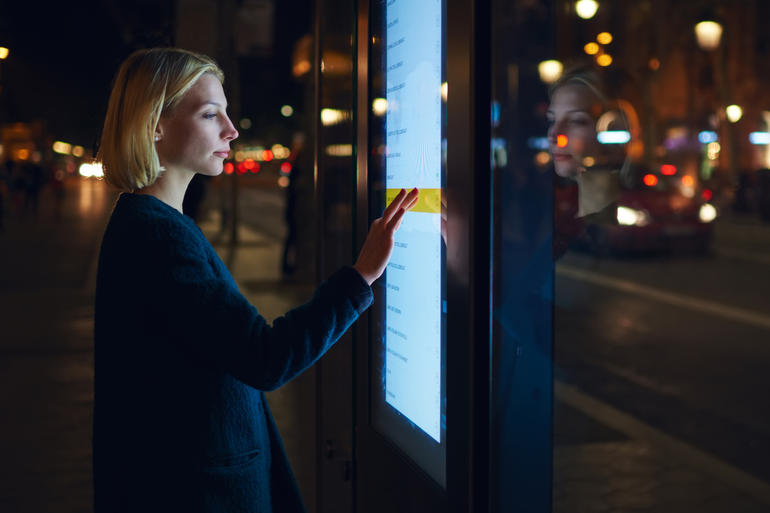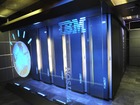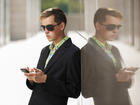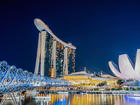
Smart kiosks make the lives of citizens easier in a smart city.
If a city is going to invest in smart technology, then it makes sense to start out doing it in the smartest way possible. While it can be different for each city, there are several common areas municipalities have used to kickstart their journey toward becoming smarter.
Smart city growth is on the rise, with the smart city industry projected to be a $400 billion market by 2020, spread out over 600 smart cities worldwide, according to McKinsey research.
"If you are a city leader and you want to come up with your entry point, I think that your perspective would be, 'What can I do initially that would have a broad impact and appeal on citizens of my city?' It needs to touch people, and identifying what that is could be different for different cities," said Carl Piva, vice president of strategic programs at TM Forum.
SEE: How to finance a smart city project (ZDNet)
Connect with citizens and create a dialogue
Finding out what matters to citizens and what makes them feel like the city cares about them needs to be a priority.
In Boston, there's a simple mobile app for the city that allows citizens to take a photo of something that needs repair, such as a pothole, and report it to the city. "Rather than that disappearing into a voice of nothingness, the city corrects it and, when they correct it, they take a photo of the guy doing the repair and send it back to the person who reported it, closing the loop and continuing the conversation," Piva said.
"To me, that is a very good way of connecting with citizens and taking care of what they care about," he said. "Find a point that takes citizen interest first, but can impact many people in a city and get visibility and become a symbol of a smart city. Ask, 'What can I do to make my city more equitable, more inclusive or to simply create a dialogue with the people who live there?'"
In Chicago, citizens can look at a real-time mobile app to find out whether their street has been plowed during the winter months and if not, when the plow and/or salt spreader is due to arrive. Building violations, broken street lights, uncleared sidewalks and graffiti removal can all be reported to the city and the data is collected and analyzed. The city, working with the University of Chicago's Argonne National Laboratory, recently installed the first of 500 modular sensor nodes on smart streetlights. They are Wi-Fi linked across the city and will give block-by-block data on air quality, traffic and noise levels, said Brenna Berman, CIO for Chicago. The installation was funded by a $3.1 million grant from the National Science Foundation.
"We'll be collecting a huge amount of data to better understand the environment, infrastructure and activities across the city," Berman said.
SEE: Louisville and the Future of the Smart City (ZDNet)
Find projects with ROI
Projects that have a clear return on investment (ROI) are an easy entry point, particularly with energy efficient technology. In Los Angeles, the city is saving on utility costs as the result of its installation of smart LED streetlights. Over the past seven years, it's converted the majority of its 215,000 streetlights to LED smart lights at a cost of $57 million. With annual savings of $9 million on utility costs, in just over six years the lights will have paid for themselves.
"That streetlight is everywhere in your city and it's got power to it and you can do so many things with it, now and in the future, if you think big first," said Jesse Berst, chairman of the Smart Cities Council.
Smart streetlights can support gunshot and sound detectors, video cameras, city communications modules, weather sensors to provide a canopy network throughout a city.
There are safety implications as well, with brighter lights reducing crime in Los Angeles, and police able to pinpoint gunshots and arrive on the scene without waiting for a citizen to report a crime.
SEE: Gunshot detection technology as part of smart city design (TechRepublic)
Eliminate silos in government
"Cities have been working as silos for 200 years in this country, and 400 years in Europe, so it's just natural for people to be specialized," Berst said. But in a smart city, city officials need to talk to each other and know what each department is doing so that efforts aren't duplicated and data and technology can be shared throughout departments.
"Our little mantra is think big, start small, move fast. Many if not most cities start small and a few move fast, but most must start small. That's really a problem if you don't think big first because you end up with isolated pockets in innovation stuck in siloed departments. You're not sharing data with other departments," Berst said.
Cities such as Vienna, Austria, and Montreal, Canada, have managed to plan big, and then divide into phases to get started down the smart city path, but this has proven to be the exception rather than the rule. "We don't see that enough," Berst said.
"It's much better to think big first, and that can be as simple as getting all your departments in a room and finding out what they'd like to do next, finding synergies in between them. It's starting small but doing it in a feature friendly way. If you're putting in a city wide network for your smart traffic or whatever it is, do it in a way that you could later come back and expand that network to carry your smart water meter data," Berst said.
Having a smart city platform in place that allows a city to have horizontal capabilities means that it start anywhere, even with verticals, since they are sharing data with other departments, said Munish Khetrapal, managing director of Smart+Connected Communities, Cisco.
"But it's very important to not build a siloed infrastructure. The day you build a siloed infrastructure you've wasted 30% of the dollars taxpayers are spending," Khetrapal said.
A traffic intersection is a classic example of a siloed infrastructure. A traffic light automatically changes the time it takes to go from red to green, but that builds traffic congestion since it's based on assumptions and not actual data, he explained.
"What we recommend to the DoT in the US and they're now looking at piloting is that, when you're collecting that information on the number of cars, you send it to a common smart city data platform to analyze and instantly send you back that information on when to change the light from red to green," he said.
SEE: How not to do a smart city: Let a thousand flowers bloom instead of having a plan (ZDNet)
Provide open data to the public
One of the key ways that cities can move into the smart city realm is by analyzing the data that is being collected by city systems, and it can be as simple as compiling information from transportation-related services such as parking tolls and ticketing, said Cheryl Wiebe, practice lead for analytics of things at Teradata.
"Data moves extremely fast and a lot of cities are looking at all of the data that gets produced by these systems, such as parking systems, toll systems and traffic lighting. They all produce data," Wiebe said.
It's important to make data accessible to the public. In Albuquerque, N.M., data was made available in machine readable format, and citizens began using that information online rather than calling the city's 311 non-emergency hotline. "Albuquerque had 422,000 fewer calls to 311 once they put it out there. As a city, you save money on Freedom for Information requests, and you create this data repository that your departments can start using and your citizens can start using and your hackers and developers can start using to build great things," Berst said.
"Open data also has some real political implications. If you really believe in accountability and transparency, a lot of these open data things help you achieve that," Berst said.
Berman said Chicago and its residents will benefit from the data collected on the 500 new sensor nodes, which began to be installed in August 2016, because it gives information about not just traffic conditions, but also the environment, with a strong focus on air quality. The city hopes to better understand urban pockets of asthma, for instance. And better analyze the weather. On the new nodes, one camera points directly into the sky to assess cloud cover and give feedback to climatologists.
The vast amount of data collected will be more than the city has the personnel to analyze, so it's shared publicly in order to allow others to analyze as well.
"We made it available to the public and encourage them in other ways to engage with us and understand what we are doing. It's a public and open process," Berman said. "The assessments themselves could take quite a while, but the data itself will be made public so that other people can begin working with the data as early as January. We're really creating this treasure trove of urban data that anyone can use."
SEE: How the city of Louisville is using IoT and big data (ZDNet)
Three takeaways for TechRepublic readers:
- There are four common ways to begin a journey toward becoming a smart city, including connecting with citizens to create a dialogue and finding projects with ROI.
- Chicago recently began installing 500 sensor nodes on smart streetlights throughout the city to assess traffic, sound, weather and other environmental factors.
- Providing citizens with open data allows for more people to analyze the information collected.
Also see
- The world's smartest cities: What IoT and smart governments will mean for you (TechRepublic)
- 16 tech jobs that will be needed for the future of smart cities (TechRepublic)
- Smart cities: The smart person's guide (TechRepublic)
- Pittsburgh's smart city efforts include autonomous driving, open data, and renewable energy (TechRepublic)
- Columbus, Ohio: What's next for the DoT Smart City Challenge winner (TechRepublic)
Full Bio
Teena Maddox is a Senior Writer at TechRepublic, covering hardware devices, IoT, smart cities and wearables. With a background in fashion writing at People and W magazines and WWD, she ties together the style and substance of tech.








